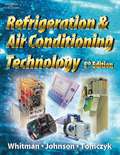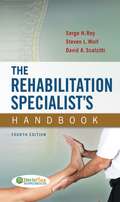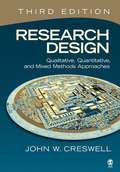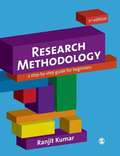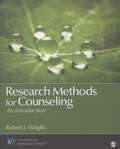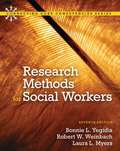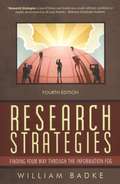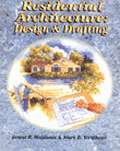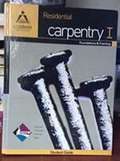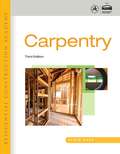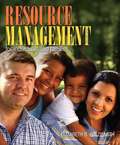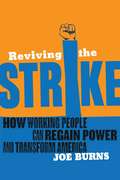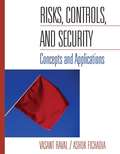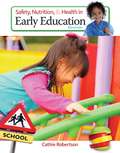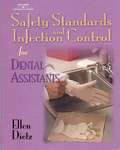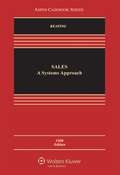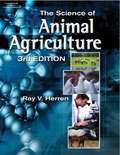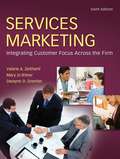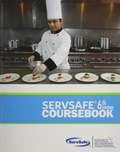- Table View
- List View
Refrigeration and Air Conditioning Technology (5th Edition)
by William C. Whitman Bill Johnson John TomczyckRefrigeration and Air Conditioning Technology is designed and written for students in vocational-technical schools and colleges, community colleges, and apprenticeship programs. The content is in a format appropriate for students who are attending classes full-time while preparing for their first job, for students attending classes part-time while preparing for a career change, or for those working in the field who want to increase their knowledge and skills. Emphasis throughout the text is placed on the practical applications of the knowledge and skills technicians need to be productive in the refrigeration and air-conditioning industry.
Registered Health Information Technician (RHIT) Exam Preparation Sixth Edition
by Darcy Carter Patricia ShawConfidently prepare for the RHIT exam with Registered Health Information Technician (RHIT) Exam Preparation. The exam experience is simulated in this textbook with 850 multiple choice questions, including two complete practice exams based on the RHIT competency statements. Whether you're still learning or ready to test your skills immediately, RHIT Exam Preparation will help prepare you for exam day.
The Rehabilitation Specialist's Handbook (Fourth Edition)
by Serge H. Roy Steven L. Wolf David A. ScalzittiThe 4th Edition of the gold standard of rehabilitation resources is now in full color and thoroughly revised and updated to reflect the art and science of practice today! A compendium of frequently used, but rarely memorized information organized for easy reference, it covers an extraordinary breadth of topics--from the full range of basic scientific information (neuroanatomy and clinical neurology, osteology and clinical orthopedics, general anatomy, cardiac and pulmonary anatomy) to the treatments and methods used in modern rehabilitation practice. With its outcome and evidence-based focus and several expert contributors, this text is a must for PT's at any stage in their career.
Research Design: Qualitative, Quantitative, and Mixed Methods Approaches
by John W. CreswellThe Bestselling Text is Completely Updated and Better than Ever Praise for the Third Edition I have used the older edition with great success. The new one is even better. -Kathleen Duncan, "University of La Verne" The Third Edition of the bestselling text Research Design by John W. Creswell enables readers to compare three approaches to research-qualitative, quantitative, and mixed methods-in a single research methods text. The book presents these three approaches side by side within the context of the process of research from the beginning steps of philosophical assumptions to the writing and presenting of research. Written in a user-friendly manner, Creswells text does not rely on technical jargon. He cuts to the core of what a reader needs to know to read and design research in part by showcasing ideas in a scaffold approach so that the reader understands ideas from the simple to the complex. Key updates to the Third Edition Presents the preliminary steps of using philosophical assumptions in the beginning of the book Provides an expanded discussion on ethical issues Emphasizes new Web-based technologies for literature searches Offers updated information about mixed methods research procedures Contains a glossary of terms Highlights research tips throughout the chapters incorporating the author s experiences over the last 35 years.
Research Methodology: A Step-By-Step Guide for Beginners (3rd Edition)
by Ranjit KumarThe Third Edition of Research Methodology: A Step-by-Step Guide for Beginners integrates various quantitative and qualitative methodologies into eight practice-based-steps, providing lots of examples throughout to link theory with practice. Written specifically for students with no previous experience of research and research methodology, the writing style is simple and clear and the author presents this complex subject in a straightforward way that empowers readers to tackle research with confidence. The book has been revised and updated to include extended coverage of qualitative research methods in addition to existing comprehensive coverage of quantitative methods. There are also brand new learning features such as reflective questions throughout the text to help students consolidate their knowledge.
Research Methods For Counseling: An Introduction
by Robert J. WrightResearch Methods for Counseling: An Introduction provides a rich, culturally sensitive presentation of current research techniques in counseling. Author Robert J. Wright introduces the theory and research involved in research design, measurement, and assessment with an appealingly clear writing style. He addresses ways to meet the requirements of providing the data needed to facilitate evidence-based therapy and interventions with clients, and also explains methods for the evaluation of counseling programs and practices. This comprehensive resource covers a broad range of research methods topics including qualitative research, action research, quantitative research including, sampling and probability, and probability-based hypothesis testing. Coverage of both action research and mixed methods research designs are also included.
Research Methods for Social Workers
by Bonnie L. Yegidis Robert W. Weinbach Laura L. MyersThis social work research methods text is written in an accessible, reader-friendly style and includes numerous examples of how research can be used to inform social work practice. It is part of the Connecting Core Competencies Series that integrates CSWE's core competencies and practice behaviors throughout.
Research Strategies: Finding Your Way Through the Information Fog 4th Edition
by William BadkeBecause of the dynamic nature of the Internet, any web addresses or links contained in this book may have changed since publication and may no longer be valid. The views expressed in this work are solely those of the author and do not necessarily reflect the views of the publisher, and the publisher hereby disclaims any responsibility for them.
Residential Architecture: Design and Drafting
by Ernest R. Weidhaas Mark D. WeidhaasThis comprehensive text provides a complete overview for beginning and intemediate students. With equal emphasis on design and drafting, the book leads students through the design of a contemporary home from preliminary program to finished rendering, with plans included in relevant chapters. Applied academics are integrated throughout the text, applying math, social studies, science, and communication to the field of architectural drafting. Career profiles give students the perspective they need to plan their own careers. Beyond the basics, the text also explores such contemporary issues as environmental sensitivity, accessibility for the physically challenged, alternate energy sources, radon control, earthquake protection, and construction administration, to name a few. A complete set of plans exposes students to commercial construction. Features on computers and the Internet prepare students for the technological challenges they will encounter in the workforce. An ideal introduction to architectural drafting and design!
Residential Carpentry: Student Guide Level 2
by Nccer StaffThe material in this textbook will help you prepare for a career in residential carpentry.
Residential Carpentry I: Foundations and Framing
by Nccer StaffThe material in this textbook will help you prepare for a career in residential carpentry.
Residential Construction Academy: Carpentry (Third Edition)
by Floyd VogtBased on industry standards developed by the National Association of Home Builders and its Home Builders Institute, this comprehensive text covers the essentials of residential construction carpentry, including tools and materials, rough carpentry, and exterior and interior finish carpentry ensuring professional success on any jobsite. Extensively illustrated and succinctly written, RESIDENTIAL CONSTRUCTION ACADEMY: CARPENTRY 3e features "Procedure" sections in nearly every chapter that combine precise, step-by-step instructions with helpful drawings, making it easy to understand key concepts and master important techniques. The Third Edition includes much new and updated material, including special "green" features exploring environmentally friendly building practices, and exercises incorporating local building codes. As always, safety is strongly emphasized with specific tips and precautions in every chapter.
Residential Hydronic Heating: Installation & Design (I=B=R Guide RHH)
by Air Conditioning Heating Refrigeration InstituteI=B=R Guide RHH, "Residential Hydronic Heating Installation & Design Guide," provides general information on the application and installation of hydronic water and steam systems for residential heating.
Resource Management For Individuals And Families (Fifth Edition)
by Elizabeth B. GoldsmithResource Management for Individuals and Families contains 14 well-organized chapters divided into four parts to introduce students to the best of management thinking and practice. The fifth edition offers a new, interactive approach to teaching resource management through special features that are specifically designed to reflect the themes of choice and decision making, supporting students' interest and learning. To engage the reader, many chapters begin with a case or story from the news about families. This edition continues to pay close attention to meeting the standards and criteria for the Certified Family Life Educator (CFLE) designation of the National Council on Family Relations (NCFR).
Reviving the Strike: How Working People Can Regain Power and Transform America
by Joe BurnsIn Reviving the Strike, Joe Burns draws on economics, history and current analysis in arguing that the labor movement must redevelop an effective strike based on the now outlawed traditional labor tactics of stopping production and workplace-based solidarity.
Risk Management for Enterprises and Individuals
by Etti Baranoff Patrick Lee Brockett Yehuda KahaneThis book is intended for the Risk Management and Insurance course where Risk Management is emphasized. When we think of large risks, we often think in terms of natural hazards such as hurricanes, earthquakes or tornados. Perhaps man-made disasters come to mind such as the terrorist attacks in the U.S. on September 11, 2001. Typically we have overlooked financial crises, such as the credit crisis of 2008. However, these types of man-made disasters have the potential to devastate the global marketplace. Losses in multiple trillions of dollars and in much human suffering and insecurity are already being totaled, and the global financial markets are collapsing as never before seen. We can attribute the 2008 collapse to financially risky behavior of a magnitude never before experienced. The 2008 U.S. credit markets were a financial house of cards. A basic lack of risk management (and regulators' inattention or inability to control these overt failures) lay at the heart of the global credit crisis. This crisis started with lack of improperly underwritten mortgages and excessive debt. Companies depend on loans and lines of credit to conduct their routine business. If such credit lines dry up, production slows down and brings the global economy to the brink of deep recession or even depression. The snowballing effect of this failure to manage the risk associated with providing mortgage loans to unqualified home buyers have been profound, indeed. When the mortgages failed because of greater risk- taking on the Street, the entire house of cards collapsed. Probably no other risk-related event has had, and will continue to have, as profound an impact world wide as this risk management failure. How was risk in this situation so badly managed? What could firms and individuals have done to protect themselves? How can government measure such risks (beforehand) to regulate and control them? These and other questions come to mind when we contemplate the consequences of this risk management fiasco. Standard risk management practice would have identified sub-prime mortgages and their bundling into mortgage-backed-securities as high risk. People would have avoided these investments or would have put enough money into reserve to be able to withstand defaults. This did not happen. Accordingly, this book may represent one of the most critical topics of study that the student of the 21st century could ever undertake. Risk management will be a major focal point of business and societal decision making in the 21st century. A separate focused field of study, it draws on core knowledge bases from law, engineering, finance, economics, medicine, psychology, accounting, mathematics, statistics and other fields to create a holistic decision-making framework that is sustainable and value- enhancing. This is the subject of this book.
Risks, Controls, and Security: Concepts and Applications
by Vasant Raval Ashok FichadiaAn accountant's guide to managing control risks In today's networked world, security and risk control are no longer just the province of the IT department. Accountants and other business managers who are responsible for corporate risk management must fully understand the control and security risks that can affect the financial health of the entire organization. Risks,Controls and Security: Concepts and Applications introduces you to today's control risks and how to manage them. Beginning with basic systems controls and security awareness, the book provides you with a clear comprehension of the concepts,issues, and techniques of information security in a networked environment. Moving from theory to application, you'll cover all the key security principles that are applicable to all businesses,including e-businesses: * Enterprise risk management * Control and security frameworks * Basic cryptography and public key infrastructure * Security for operating systems, applications, database management systems, and telecommunications * Network and web security * Policy, regulation, and ethics Real-world problem scenarios and a wealth of pedagogical features--discussion questions, short exercises, example cases, and"concept maps" that help you visualize the material--ensure your confident grasp of the material and enable you to put "security into practice." Designed for practicing professionals as well as for students in accounting, business management, and computer science, Risks,Controls and Security will prepare you well for meeting the challenge of protecting information assets.
Safety and Sanitation (Second Edition)
by Michael R. PepperEmpowers its readers on public health and safety by providing guidelines for safety and sanitation.
Safety, Nutrition, Health in Early Education
by Cathie RobertsonSAFETY, NUTRITION, AND HEALTH IN EARLY EDUCATION uses theory, practical applications, and resources to prepare readers for a career in working with children from birth to age eight in multicultural and socioeconomically diverse early childhood settings. This book emphasizes healthy development, including environmental health and safety, active supervision, and how issues surrounding safety, nutrition, health, child maltreatment, and mental and emotional health can affect brain development. It also fully integrates NAEYC, DAP, and AAP/APHA professional standards throughout, and includes strategies for how to engage diverse families from various backgrounds and beliefs, and also those whose children have special needs.
Safety Standards and Infection Control for Dental Assistants
by Ellen Dietz-BourguignonInfection Control for Dental Assistants addresses the requirements set forth by the Dental Assisting National Board (DANB) Task Analysis to prepare students for the national Infection Control Examination (ICE). To facilitate instruction and learning the text is broken down into six major areas - Microbiology and Disease Prevention Specific to Dentistry; National Guidelines, Recommendations and Regulations; Infection Control Techniques; Environmental Health and Safety; and Office Communications Regarding Infection Control - according to their relevance to the dental assistant's role in infectious disease prevention. Numerous hands-on procedures and assessment questions are designed to help students track their comprehension and retention of presented material.
Sales: A Systems Approach (Fifth Edition, Aspen Casebook Series)
by Daniel KeatingA problem-based casebook organized using sales systems including those governing domestic sales of goods, leases, international sales, and real estate sales.
The Science of Animal Agriculture (3rd edition)
by Ray V. HerrenThe Science of Animal Agriculture, third edition, is designed for courses aimed at teaching science along with concepts associated with the industry of animal agriculture. This book responds to the current trends in education that promote connecting academic theory with real world applications. Research shows that students gain a better grasp of scientific theory if the theories are taught in an application context, and this text presents the application of biological science used in producing and caring for animals. Topics such as nutrition, anatomy, genetics, entomology, pathology, and animal behavior are covered in depth. These complicated areas are presented in the context of how they are used in the animal industry, allowing the student to make a distinct correlation. Students will benefit from this science-based, animal agriculture text that makes complicated biology principles easy to grasp the context of their application.
Sequel: A Handbook for the Critical Analysis of Literature
by Elizabeth Schmuhl Richard C. Guches Meredith Mayberry Jill PeekTextbook for the study and analysis of poetry, fiction, and drama
Services Marketing: Integrating Customer Focus Across the Firm
by Valarie A. Zeithaml Mary Jo Bitner Dwayne D. GremlerServices Marketing, 6/e, is written for students and businesspeople who recognise the vital role that services play in the economy and its future. The advanced economies of the world are now dominated by services, and virtually all companies view service as critical to retaining their customers today and in the future. This edition focuses on knowledge needed to implement service strategies for competitive advantage across industries. In addition to standard marketing topics (such as pricing), this text introduces students to entirely new topics that include management and measurement of service quality, service recovery, the linking of customer measurement to performance measurement, service blueprinting, customer cocreation, and cross-functional treatment of issues through integration of marketing with disciplines such as operations and human resources. Each of these topics represents pivotal content for tomorrow's businesses as they attempt to build strong relationships with their customers.
Servsafe Coursebook (Sixth Edition)
by National Restaurant Association StaffLearn everything you need to know about safe food handling, how to train your employees, what to watch for to make sure you and the people around you stay healthy, how to keep a safe and sanitary work environment.
